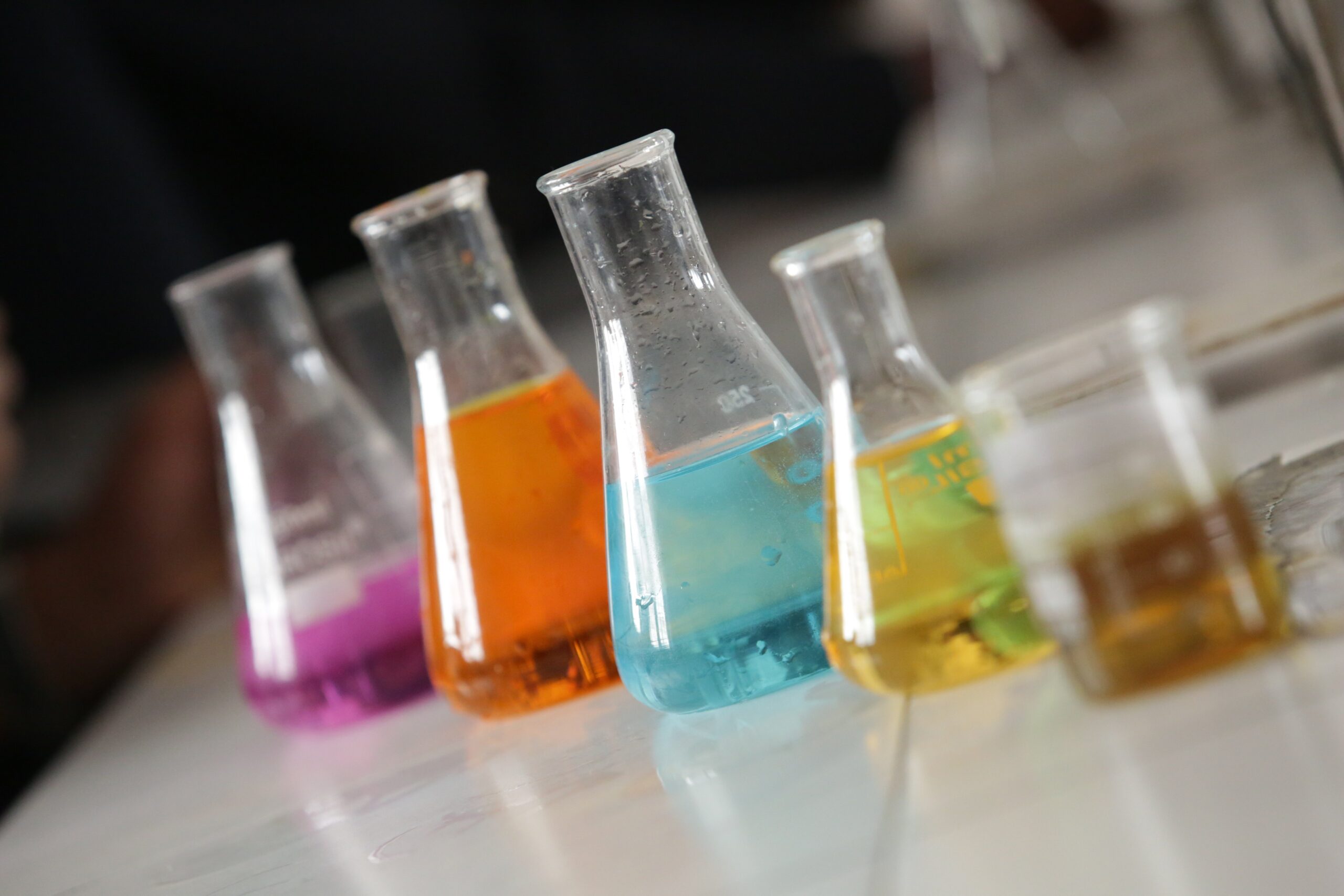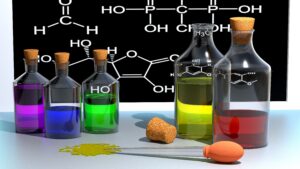
By Al Adcock, Vice President Sales & Marketing, B&C Technologies
Last week in Part 1 we explored different products that can be used in your commercial laundry. This week we’ll look at more chemicals, their composition and how they enhace the goods moving through your facility. Read Part 1 here.
What is Chlorine Bleach?
Chlorine bleach works by using its active ingredient, sodium hypochlorite, to break down stains through a chemical process called oxidation. Sodium hypochlorite in chlorine bleach releases oxygen when it comes into contact with water. This oxygen reacts with the molecules in stains, breaking apart the bonds that give them their color. By altering the molecular structure of the stain, it effectively makes the stain colorless or soluble in water, allowing it to be washed away.
Many stains, such as food, sweat, or grass stains, are organic in nature. Chlorine bleach breaks down the proteins and other organic compounds in these stains into smaller, more water-soluble fragments, which can then be rinsed away during the wash cycle.
Chlorine bleach also kills bacteria, fungi, and viruses, which is an added benefit for sanitizing laundry. This is especially useful for cleaning items like towels, bedding, and clothing exposed to germs.
Important Considerations:
Fabric Safety: Chlorine bleach is strong and can weaken or discolor delicate or non-white fabrics. Always check the care label and do a spot test.
Avoid Mixing with Other Chemicals: Never mix chlorine bleach with ammonia or acidic cleaners (like vinegar), as this can release toxic chlorine gas.
Effectiveness on Different Stains: Chlorine bleach is most effective on white fabrics and stains that are oxidizable, such as wine or coffee, but less effective on grease or oil-based stains.
By understanding its mechanism and proper use, chlorine bleach can be a powerful ally in removing stains and sanitizing laundry.
Non-chlorine bleach, also known as oxygen bleach or color-safe bleach, works by using oxidizing agents to break down stains and brighten fabrics without the harshness of chlorine bleach. Its active ingredient is usually hydrogen peroxide or compounds that release hydrogen peroxide, like sodium percarbonate or sodium perborate. Non-chlorine bleach releases oxygen when dissolved in water. This oxygen interacts with the molecules in stains, breaking down their structure and making them colorless or water-soluble. This process works effectively on organic stains such as coffee, tea, wine, or sweat.
Unlike chlorine bleach, which can damage or discolor fabrics, non-chlorine bleach is gentler and safe to use on most colored or delicate fabrics. It doesn’t strip dyes but instead enhances brightness by removing dinginess caused by stains or residue. By oxidizing and removing stains, it improves the overall appearance of garments without the risks associated with chlorine bleach.
Hydrogen peroxide, the active ingredient in most non-chlorine bleaches, also has mild antibacterial properties. While not as potent as chlorine bleach, it can still help reduce bacteria and odors on fabrics. Non-chlorine bleach is often considered a more eco-friendly alternative to chlorine bleach because it breaks down into water and oxygen after use, leaving fewer harmful byproducts.
Non-chlorine bleach is excellent for light stains and general brightening but may not be as effective on heavy or stubborn stains as chlorine bleach. It’s also generally safe to use on most fabrics, but always check care labels for specific instructions. Non-chlorine bleach often works best in warm or hot water, as heat activates the oxygen-releasing compounds.
What is Fabric Softener?
Fabric softeners work by coating the fibers of fabrics with a thin layer of chemicals that alter their texture and reduce static electricity. Fabric softeners contain cationic surfactants, which are positively charged molecules. These molecules bind to the negatively charged surfaces of fabric fibers, creating a smoother surface. This coating reduces the stiffness of the fibers, making them feel softer to the touch.
Static cling occurs when fabrics rub together (a typical occurrence in a tumble dryer, where the humidity is low), causing an accumulation of static electricity, especially in synthetic materials like polyester. The coating provided by fabric softeners neutralizes the charge on fabric fibers, minimizing static buildup and making garments easier to separate after washing or drying.
The lubricating effect of fabric softeners reduces friction between fibers, which can make clothes easier to iron and help them resist wrinkling. This coating can also help maintain the texture of delicate fabrics over time. However, fabric softeners reduce the absorbency of towels and other goods because of the residue left which interferes with the fibers of the goods ability to come into contact with moisture.
What is Laundry Sour?
Laundry sour chemicals, often referred to simply as “sours,” are used in commercial and industrial laundry processes to neutralize alkaline residues and maintain fabric quality. Detergents, bleach, and other laundry chemicals are typically alkaline (high pH) to enhance cleaning. However, if these alkaline residues are left on fabrics, they can cause skin irritation, contribute to fabric wear and tear over time, and lead to yellowing or discoloration.
Laundry sours are acidic chemicals (low pH), such as acetic acid or citric acid, that counteract these alkaline residues. By neutralizing the pH, sours leave the fabric at a skin-friendly and fabric-safe pH level. If left in the goods, alkaline residues can make fabrics feel stiff. By neutralizing these residues, sours restore a softer texture to fabrics, enhancing comfort.
In regions with hard water, minerals like calcium, magnesium, or iron can interact with alkaline residues, causing deposits or discoloration (e.g., yellowing). The acidic nature of sours helps dissolve and prevent these deposits, keeping fabrics bright and clean.
Prolonged exposure to high alkalinity can degrade fibers, leading to brittleness and damage over time. Sours protect fabrics by ensuring a balanced pH, which reduces chemical stress on the fibers.
Proper dosing is critical, as overuse can result in overly acidic fabrics, which can also cause damage or irritation. Also ensure sours are compatible with the detergents and other chemicals used in the laundry process (your chemical representative should cover this).
Laundry sours are essential for achieving high-quality, residue-free results in professional laundry operations.
Conclusion
Modern wash chemistry is both safe and powerfully effective when used properly and expertise is required to do so. Improper dosing of any of the above chemicals can cause issues not only in the washer, but in subsequent processes like drying and ironing. These chemicals must also be respected when handling, as they can cause injury if they come into direct contact with the skin. Proper PPE is essential when handling laundry chemicals.
Al Adcock is VP of Sales and Marketing at B&C Technologies. He is an industry veteran with over 30 years of experience, working for different manufacturers in many different capacities before helping launch B&C Technologies in 2000. Adcock has played an instrumental role in the design of several machines on the market before moving to sales in 2013.
Based in Panama City Beach, FL, B&C Technologies is a family-owned customer-focused company that builds the highest quality laundry equipment at the most competitive prices. All B&C equipment relies on engineering-driven designs to produce machines that consistently perform and constantly produce.















